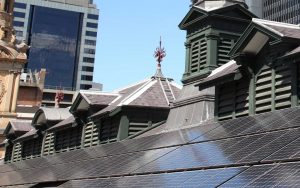Can supermarkets be Australia’s renewable energy secret weapon?
Could the nation’s shopping centres and supermarkets play a key role in Australia’s drive towards net zero?

Shell Energy Australia (Shell) supplies electricity and gas to commercial and industrial (C&I) sites across the country. With ARENA’s help, Shell plans to recruit customers across Queensland, New South Wales and Victoria to demonstrate an estimated 21.5 MW of flexible demand.
If successful, the project will tackle barriers to broader uptake of flexible demand services.
Shell Energy’s plan is to directly unlock 417 MW of flexible demand. And by the end of 2025, Shell aims to have been the catalyst for 1000 MW uptake across the National Energy Market (NEM).
What is flexible demand?
Flexible demand is involves shifting energy usage to when energy market prices are lower, or from when demand is peaking.
Low market price periods are typically during the middle of the day and night, while higher price periods usually occur in the morning and evening.
The middle of the day is also when solar power production is at its highest.
Flexible demand can also involve demand response which involves curbing energy consumption during extreme peak periods such as a summer heatwave.
Electricity demand fluctuates on a daily cycle. This demand is constantly matched with a mixture of supply from renewable and fossil fuel sources. But what if we could shift energy demand to periods when renewable energy is both cheap and plentiful?
That would cut power bills for businesses, reduce energy waste, lessen demand for network upgrades and storage, and relieve pressure on the electricity network.
ARENA CEO Darren Miller said supporting flexible demand is important to optimise the transition to renewable electricity.
“For commercial and industrial sites, flexible demand is seen as a viable solution and alternative to upgrading costly network infrastructure or building large scale batteries” he said.
Flexible demand can even be aggregated and controlled similar to batteries to respond to signals from the grid, so avoiding the need for more generation or more storage.
So, where to start?
Shell has identified the shopping centres, supermarkets and refrigerated distribution centres it provides power to as prime candidates.
Together, they represent the largest medium-term opportunity for developing flexible demand capacity. They all carry large thermal energy loads with opportunities to manage heating and cooling. There’s also a strong retail industry push to move to sustainable outcomes where possible.
ARENA is providing $9.1 million in funding to Shell to demonstrate flexible demand capacity.

The $31.6 million project to commercialise Shell’s Smart Energy Hubs will cover at least 40 commercial and industrial customer sites.
The idea is to optimise energy use across the whole of these sites. That will include heating, ventilation, air conditioning, refrigeration, electric vehicle charging control, and onsite solar PV and storage.
Mr Miller said Shell’s project could be a big step towards unlocking flexible demand across commercial and industrial sectors.
“In order to achieve the full potential of flexible demand, we will require new innovation, technologies and market processes,” he said
“Shell Energy’s Commercialising Smart Energy Hubs initiative represents ARENA’s first C&I project to demonstrate a whole of site optimisation of energy demand management for delivery of market, ancillary and customer benefits through the control of energy load.”
LIKE THIS STORY? SIGN UP TO OUR NEWSLETTER

ARENA